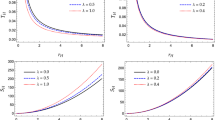Summary
It is shown that, for static space-times, the phenomenon of Hawking radiation can be understood in terms of representations of the twodimensional Poincaré group. Thero zero-energy basis vector of one representation contains positive-energy basis vectors of another representation. An action of the two-dimensional Poincaré group is globally defined over the whole of space-time, but only generates isometries at the event horizon and in the asymptotically flat region (where it degenerates to simple translations). Some simple space-times are discussed.
Riassunto
Si mostra che, per spazi-tempo statici, si può comprendere il fenomeno della radiazione di Kawking nei termini delle rappresentazioni del gruppo di Poincaré a due dimensioni. Il vettore di base ad energia zero di una rappresentazione contiene vettori di based ad energia positiva di un’altra rappresentazione. Un’azione del gruppo di Poincaré a due dimensioni è globalmente definita su tutto lo spazio-tempo, ma genera solo isometrie all’orizzonte degli eventi e nella regione asintoticamente piatta (dove degenera in semplici translazioni temporali). Si discutono alcuni semplici spazi-tempo.
Резюме
Показывается, что для стаических пространства-времени явление излучения Хокинга можно понять в терминах представлений двумерной группы Пуанкаре. Базисный вектор нулевой энергии одного представления содержит базисные векторы с положительной энергией другого представления. Действие двумерной группы Пуанкаре глобально определяется на асимптотически плоской области (где действие производит простые тременные транслции). Обсуждаются некоторые простые типы пространства-времени.
Similar content being viewed by others
References
N. O. Birrell andP. C. W. Davies:Quantum Fields in Curved Space (Cambridge University Press, 1982).
G. W. Gibbons andS. W. Hawking:Phys. Rev. D. 15, 2738 (1977).
S. W. Hawking andG. F. R. Ellis:The Large Structure of Space-Time (Cambridge University Press, 1973).
N. N. Bogoliubov:Ž. Ėksp. Teor. Fiz.,34, 58 (1958) (Sov. Phys. JETP,7, 51 (1958)).
N. Sanchez:Phys. Lett. B,87, 212 (1979).
M. D. Kruskal:Phys. Rev.,119, 1743 (1960).
S. W. Hawking:Commun. Math. Phys.,43, 199 (1975).
W. G. Unruh:Phys. Rev. D,14, 870 (1976).
B. Bertotti:Phys. Rev.,116, 1331 (1959).
I. Robinson:Bull. Acad. Polon. Sci., Ser. Math. Astr. Phys.,7, 351 (1959).
D. Kramer, H. Stephani, M. MacCallum andHerlt:Exact Solutions of Einstein’s Field Equations (DVB, 1980).
Author information
Authors and Affiliations
Additional information
To speed up publication, the author of this paper has agreed to not receive the proofs for correction.
Traduzione a cura della Redazione.
Переведено редакцией.
Rights and permissions
About this article
Cite this article
Dolan, B.P. A group-theoretical approach to black-hole radiation. Nuov Cim B 102, 649–659 (1988). https://doi.org/10.1007/BF02725620
Received:
Published:
Issue Date:
DOI: https://doi.org/10.1007/BF02725620




